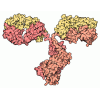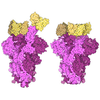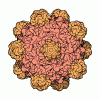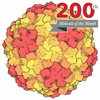+ Open data
Open data
- Basic information
Basic information
| Entry | Database: PDB / ID: 7m3l | ||||||
|---|---|---|---|---|---|---|---|
| Title | Canine parvovirus and Fab14 at partial occupancy | ||||||
 Components Components |
| ||||||
 Keywords Keywords | VIRUS/Immune System / canine parvovirus / CPV / Fab14 / VIRUS / VIRUS-Immune System complex | ||||||
| Function / homology |  Function and homology information Function and homology informationsymbiont entry into host cell via permeabilization of host membrane / T=1 icosahedral viral capsid / clathrin-dependent endocytosis of virus by host cell / virion attachment to host cell / structural molecule activity Similarity search - Function | ||||||
| Biological species |  Canine parvovirus type 2 Canine parvovirus type 2 | ||||||
| Method | ELECTRON MICROSCOPY / single particle reconstruction / cryo EM / Resolution: 3.2 Å | ||||||
 Authors Authors | Goteschius, D.J. / Hartmann, S.R. / Hafenstein, S.L. | ||||||
| Funding support |  United States, 1items United States, 1items
| ||||||
 Citation Citation |  Journal: Proc Natl Acad Sci U S A / Year: 2021 Journal: Proc Natl Acad Sci U S A / Year: 2021Title: High-resolution asymmetric structure of a Fab-virus complex reveals overlap with the receptor binding site. Authors: Daniel J Goetschius / Samantha R Hartmann / Lindsey J Organtini / Heather Callaway / Kai Huang / Carol M Bator / Robert E Ashley / Alexander M Makhov / James F Conway / Colin R Parrish / Susan L Hafenstein /  Abstract: Canine parvovirus is an important pathogen causing severe diseases in dogs, including acute hemorrhagic enteritis, myocarditis, and cerebellar disease. Overlap on the surface of parvovirus capsids ...Canine parvovirus is an important pathogen causing severe diseases in dogs, including acute hemorrhagic enteritis, myocarditis, and cerebellar disease. Overlap on the surface of parvovirus capsids between the antigenic epitope and the receptor binding site has contributed to cross-species transmission, giving rise to closely related variants. It has been shown that Mab 14 strongly binds and neutralizes canine but not feline parvovirus, suggesting this antigenic site also controls species-specific receptor binding. To visualize the conformational epitope at high resolution, we solved the cryogenic electron microscopy (cryo-EM) structure of the Fab-virus complex. We also created custom software, Icosahedral Subparticle Extraction and Correlated Classification, to solve a Fab-virus complex with only a few Fab bound per capsid and visualize local structures of the Fab-bound and -unbound antigenic sites extracted from the same complex map. Our results identified the antigenic epitope that had significant overlap with the receptor binding site, and the structures revealed that binding of Fab induced conformational changes to the virus. We were also able to assign the order and position of attached Fabs to allow assessment of complementarity between the Fabs bound to different positions. This approach therefore provides a method for using cryo-EM to investigate complementarity of antibody binding. | ||||||
| History |
|
- Structure visualization
Structure visualization
| Movie |
 Movie viewer Movie viewer |
|---|---|
| Structure viewer | Molecule:  Molmil Molmil Jmol/JSmol Jmol/JSmol |
- Downloads & links
Downloads & links
- Download
Download
| PDBx/mmCIF format |  7m3l.cif.gz 7m3l.cif.gz | 161.6 KB | Display |  PDBx/mmCIF format PDBx/mmCIF format |
|---|---|---|---|---|
| PDB format |  pdb7m3l.ent.gz pdb7m3l.ent.gz | Display |  PDB format PDB format | |
| PDBx/mmJSON format |  7m3l.json.gz 7m3l.json.gz | Tree view |  PDBx/mmJSON format PDBx/mmJSON format | |
| Others |  Other downloads Other downloads |
-Validation report
| Summary document |  7m3l_validation.pdf.gz 7m3l_validation.pdf.gz | 1.1 MB | Display |  wwPDB validaton report wwPDB validaton report |
|---|---|---|---|---|
| Full document |  7m3l_full_validation.pdf.gz 7m3l_full_validation.pdf.gz | 1.1 MB | Display | |
| Data in XML |  7m3l_validation.xml.gz 7m3l_validation.xml.gz | 37 KB | Display | |
| Data in CIF |  7m3l_validation.cif.gz 7m3l_validation.cif.gz | 52.5 KB | Display | |
| Arichive directory |  https://data.pdbj.org/pub/pdb/validation_reports/m3/7m3l https://data.pdbj.org/pub/pdb/validation_reports/m3/7m3l ftp://data.pdbj.org/pub/pdb/validation_reports/m3/7m3l ftp://data.pdbj.org/pub/pdb/validation_reports/m3/7m3l | HTTPS FTP |
-Related structure data
| Related structure data |  23656MC  7m3mC  7m3nC  7m3oC M: map data used to model this data C: citing same article ( |
|---|---|
| Similar structure data |
- Links
Links
- Assembly
Assembly
| Deposited unit | 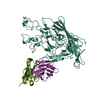
|
|---|---|
| 1 | 
|
| Symmetry | Point symmetry: (Schoenflies symbol: I (icosahedral)) |
- Components
Components
| #1: Protein | Mass: 64705.559 Da / Num. of mol.: 1 / Source method: isolated from a natural source / Source: (natural)  Canine parvovirus type 2 / References: UniProt: B2ZG07 Canine parvovirus type 2 / References: UniProt: B2ZG07 |
|---|---|
| #2: Antibody | Mass: 11981.362 Da / Num. of mol.: 1 / Source method: isolated from a natural source / Source: (natural)  |
| #3: Protein | Mass: 13104.530 Da / Num. of mol.: 1 / Source method: isolated from a natural source / Source: (natural)  |
| Has protein modification | Y |
-Experimental details
-Experiment
| Experiment | Method: ELECTRON MICROSCOPY |
|---|---|
| EM experiment | Aggregation state: PARTICLE / 3D reconstruction method: single particle reconstruction |
- Sample preparation
Sample preparation
| Component |
| ||||||||||||||||||||||||
|---|---|---|---|---|---|---|---|---|---|---|---|---|---|---|---|---|---|---|---|---|---|---|---|---|---|
| Source (natural) |
| ||||||||||||||||||||||||
| Details of virus | Empty: NO / Enveloped: NO / Isolate: SPECIES / Type: VIRION | ||||||||||||||||||||||||
| Buffer solution | pH: 7.4 | ||||||||||||||||||||||||
| Specimen | Embedding applied: NO / Shadowing applied: NO / Staining applied: NO / Vitrification applied: YES | ||||||||||||||||||||||||
| Vitrification | Cryogen name: ETHANE |
- Electron microscopy imaging
Electron microscopy imaging
| Experimental equipment | 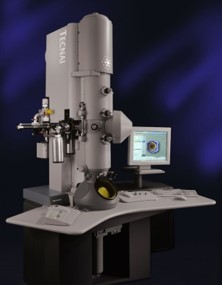 Model: Tecnai Polara / Image courtesy: FEI Company |
|---|---|
| Microscopy | Model: FEI POLARA 300 |
| Electron gun | Electron source:  FIELD EMISSION GUN / Accelerating voltage: 300 kV / Illumination mode: FLOOD BEAM FIELD EMISSION GUN / Accelerating voltage: 300 kV / Illumination mode: FLOOD BEAM |
| Electron lens | Mode: BRIGHT FIELD |
| Image recording | Electron dose: 60 e/Å2 / Film or detector model: FEI FALCON III (4k x 4k) |
- Processing
Processing
| CTF correction | Type: PHASE FLIPPING AND AMPLITUDE CORRECTION |
|---|---|
| 3D reconstruction | Resolution: 3.2 Å / Resolution method: FSC 0.143 CUT-OFF / Num. of particles: 95353 / Symmetry type: POINT |
 Movie
Movie Controller
Controller








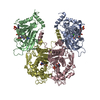
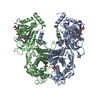

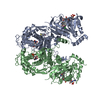
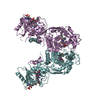
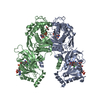
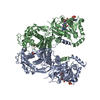
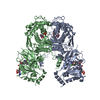
 PDBj
PDBj